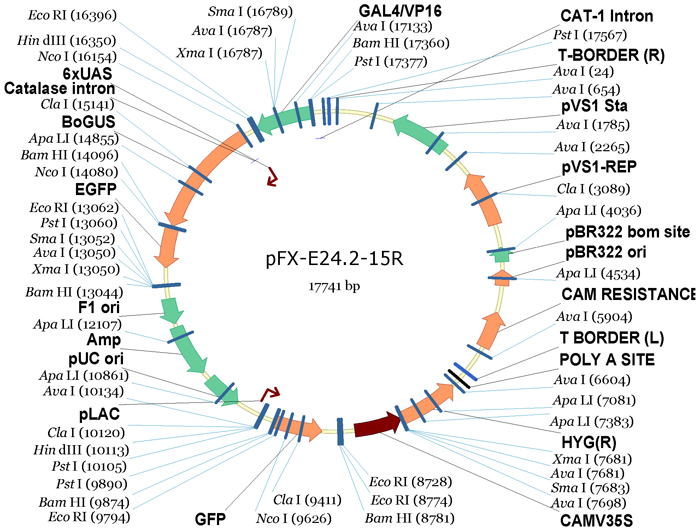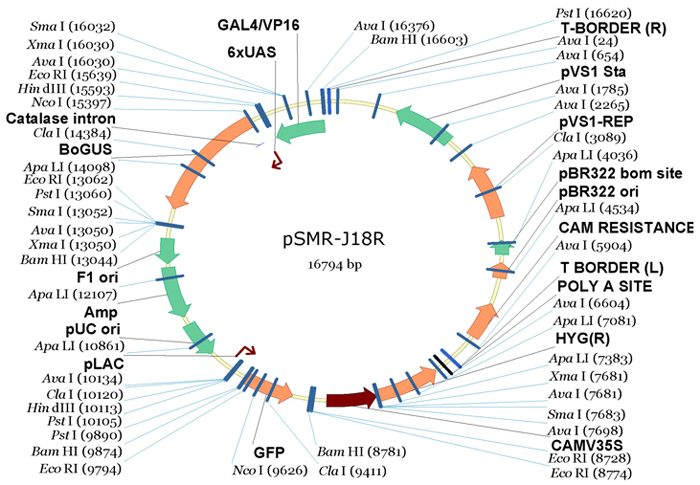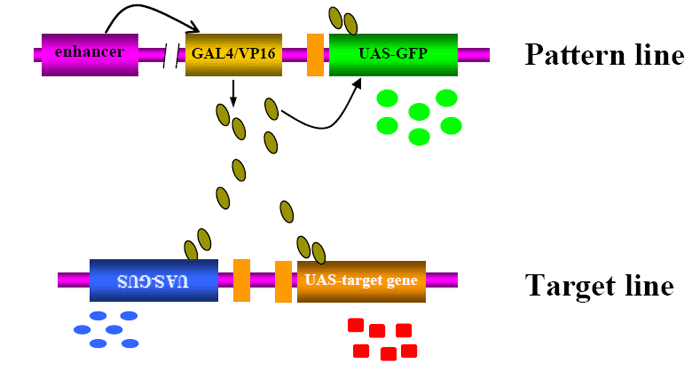|
|
|
 General Information General Information
|
Rice Mutant Database (RMD) is developed by the Wuhan group of a joint national program,
the National Special Key Program on Rice Functional Genomics of China, and maintained by
the National Center of Plant Gene Research (Wuhan) at Huazhong Agricultural University.
RMD currently (RMD update information ) contains the
information of approximate 132,193 rice T-DNA insertion (enhancer trap) lines generated
by an enhancer trap system. Comprehensive
information about mutant phenotypes, reporter-gene expression patterns,
flanking sequences of T-DNA insertional sites, seed availability, and others are collected in the database. RMD can be searched by keywords, nucleotide sequence or protein sequence. This database provides three classes of functions: (1) identifying novel genes, (2) identifying regulatory elements, and (3) identifying pattern lines for ectopic expression (misexpression) of target gene at specific tissue or at specific growth stage. ) contains the
information of approximate 132,193 rice T-DNA insertion (enhancer trap) lines generated
by an enhancer trap system. Comprehensive
information about mutant phenotypes, reporter-gene expression patterns,
flanking sequences of T-DNA insertional sites, seed availability, and others are collected in the database. RMD can be searched by keywords, nucleotide sequence or protein sequence. This database provides three classes of functions: (1) identifying novel genes, (2) identifying regulatory elements, and (3) identifying pattern lines for ectopic expression (misexpression) of target gene at specific tissue or at specific growth stage.
|
The enhancer trap
system works by random integrating into the genome a DNA cassette that contains
a minimum or incomplete promoter-reporter gene fusion. The
report gene is not expressed under this truncated promoter. Instead,
integration of the element within or fairly close to a gene in the target
genome may result in reporter gene expression activated by the regulatory sequence
of the tagged gene. We have used the enhancer trap strategy which has been originally
developed in Drosophila (Wu et al. 2003). The enhancer trap carries a gene encoding
a transcriptional activator protein GAL4/VP16, a fusion protein that activates gene
expression via its recognition and binding to a specific DNA target sequence,
upstream activator sequence (UAS).
The VP16 transcriptional activator domain effects the transcriptional activation of any gene
that is adjacent to the UAS. Enhancer
trap lines can be obtained by using combination of this transactivator gene and a
reporter gene to trap enhancer. Thus, the enhancer trap system used to generate rice mutants
collected in this database, on one side, can function as an insertion DNA, which is randomly
integrated into host genome by Agrobacterium-mediated transformation, for identifying novel genes.
On the other side, this system, based on the expression pattern of a reporter gene that can
only be expressed in the occurrence of a host enhancer element in the neighboring genomic region,
is a useful tool for identifying regulatory elements.
|
We used two constructs for generation of rice enhancer trap lines. One was kindly provided by CAMBIA (Wu et al. 2003) and the other was a modification of the CAMBIA construct by using GFP as the reporter.
|
 |
 |
 |

|
The enhancer trap lines collected in this database can be subsequently used for ectopic expression (misexpression) of target gene by introducing a second construct in which the gene of interest is placed downstream of the UAS sequence. To express a target gene in a specific tissue or at a specific growth stage, the enhancer trap line with required expression pattern collected in RMD can be used as a pattern line to cross with the target line that carries the target gene.
|
 |

|
Agrobacterium-mediated T-DNA transformation approach was used to generate transgenic (enhancer trap) lines. Analysis of over 1000 transformants showed that the transformants had two copies of T-DNA insertions on average, and approximately 40% of the transformants had a single copy of T-DNA insertion, .
|
|
|
|
|
|
Hyg resistant calli in selection medium
|
regenerated plants
|
Transgenic plants in the green house
|
|

|
We compared GUS staining patterns of 66 T1-generation lines with the
same 66 T0-generation plants and the same expression patterns were abserved
in T0 and T1, suggesting that UAS in rice was not as sensitive to methylation
as in tobacco and Arabidopsis.
|

|
1. Wu C, Li X, Yuan W, Chen G, Kilian A, Li J, Xu C, Li X, Zhou D-X, Wang S, Zhang q. Development of enhancer trap lines for functional analysis of the rice genome. Plant J., 2002, 35:418-427.
2. Zhang J, Li C, Wu C, Xiong L, Chen G, Zhang Q, Wang S. RMD: a rice mutant database for functional analysis of the rice genome. Nucl. Acids Res., 2006, 34: D745-748
|

|
|
 |
|
 |
© 2024 All Rights Reserved, National Center of Plant Gene Research (Wuhan).
Recommend: 1024*768, IE6.0/Netscape7.0 or higher Constructed by Zhang Jianwei
Update by Zhang Chengjun, E-mail:rmd_order@mail.hzau.edu.cn 
鄂ICP备05018538号
|
|
|